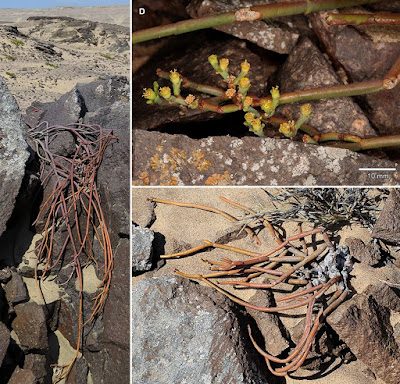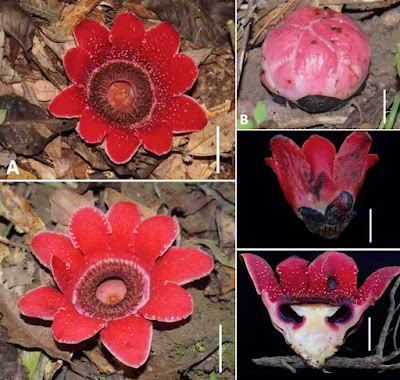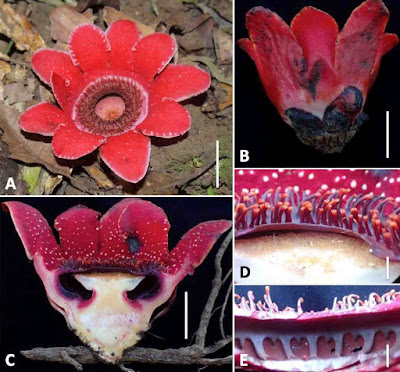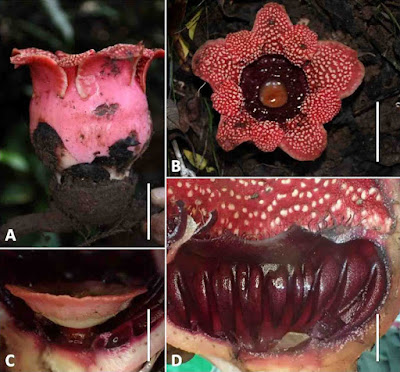[Most Recent Entries] [Calendar View]
Saturday, August 31st, 2019
| Time | Event | ||||||||||
| 10:02a | [Botany • 2019] Euphorbia rimireptans (Euphorbiaceae, Articulofruticosae) • A New Species from the Skeleton Coast, Namibia
Abstract Euphorbia rimireptans, here described as a new species, is known only from the northern part of the Skeleton Coast (part of the Namib Desert) in the Kaokoveld Centre of Endemism, northwestern Namibia. These perennial shrublets grow on rocky outcrops of latite under harsh desert conditions. Diagnostic characters for E. rimireptans include the procumbent, sometimes pendant habit, the soft, rubber-like terete or slightly tapering branches that are curved or ± straight, frequently orientated in the same direction from the base, and the glabrous or sparsely hairy capsule, which releases verrucose ovoid seeds. A comparison of some of the more prominent morphological features to differentiate between E. rimireptans and its possible nearest relative, E. giessii, is provided. Keywords: endemism, flora, Kaokoveld Centre of Endemism, latite, Namib Desert, taxonomy
Euphorbia rimireptans Swanepoel, R.W.Becker & Alma Möller sp. nov. Diagnosis:— Succulent shrublet up to 0.5 m in its greatest diam., similar to E. giessii, from which it differs in being procumbent, sometimes pendant (vs. erect, up to 0.8 m high); branches, shorter and thinner (up to 0.5 m long, 2.8–6.0 mm diam.), soft, rubber-like, terete or only slightly tapering [vs. longer and thicker (up to 0.8 m long, 4–12 mm diam.), rigid, firm, tapering]; leaf lamina not panduriform, of uniform thickness, glabrous (vs. somewhat panduriform, thickened towards apex, densely hairy at base adaxially); bracts dissimilar to the leaves, hairy adaxially at base only, otherwise glabrous (vs. bracts similar to the leaves, hairy adaxially); gland shape mostly variable on each involucre, oblong, oblong-elliptic, elliptic, reniform, ovate or flabellate (vs. gland shape uniform on each involucre, oblongelliptic, elliptic or sub-circular); staminate flowers with filaments glabrous, shorter (0.4–0.8 mm long), anther theca pale yellow [vs. filaments glabrous or with long hairs, longer (0.9–1.2 mm long), anther theca pale green]; capsule glabrous or sparsely hairy, rarely dotted, pedicel ± 0.6 mm diam. (vs. sparsely to densely hairy, seldom glabrous, conspicuously dotted, pedicel ± 1.1 mm diam.); seed verrucose. ... Etymology:— The specific epithet is derived from Latin and refers to the habit of Euphorbia rimireptans: ‘rimireptans’ = creeping from rock fissures.
Wessel Swanepoel, Rolf W. Becker, Alma Mӧller and Vera de Cauwer. 2019. Euphorbia rimireptans (Euphorbiaceae, Articulofruticosae), A New Species from the Skeleton Coast, Namibia. Phytotaxa. 414(4); 165–173. DOI: 10.11646/phytotaxa.414.4.2 | ||||||||||
| 4:22p | [Botany • 2019] Sapria myanmarensis • A New Species and A Newly Recorded Taxon of the Genus Sapria (Rafflesiaceae) [Contributions to the Flora of Myanmar IV]
Abstract In the course of our intensive floristic inventories for the flora of Myanmar, a new species of the genus Sapria (Rafflesiaceae), Sapria myanmarensis Nob. Tanaka, Nagam, Tagane & M.M. Aung is described and photographed. In addition, S. himalayana Griff. f. albovinosa Bänziger & B. Hansen is newly recorded in the country. A key to the species of Sapria presently occurring in Myanmar is provided. Keyword: Burma, Inventory, Myanmar, Parasitic plant, Rafflesiaceae, Sapria myanmarensis, Sapria himalayana f. albovinosa Sapria myanmarensis Nob. Tanaka, Nagam., Tagane & M.M. Aung, sp. nov. Diagnosis: Similar to Sapria himalayana Griff., but it is distinguished from it by a combination of features including vermilion perigone lobes with white-colored warts distributed only basally, a shorter perigone tube (1.5–2 cm vs. 3–4 cm in S. himalayana), a flat central disk (not bowl- or pan-shaped), a greater diameter of the disk crest (4–4.5 cm in diam. vs. 3.5–3.9 cm in diam. in S. himalayana) and crateriform ramenta. .... Distribution: Endemic to Myanmar. Thus far known only from northwestern part (Kachin State and Sagaing Region). Etymology: The specific epithet is derived from the name of the country. Vernacular name (Myanmar): Taung Kyar, meaning “mountain lotus flower”. Nobuyuki Tanaka, Hidetoshi Nagamasu, Shuichiro Tagane, Mu Mu Aung, Aung Khaing Win and Phyu Phyu Hnin. 2019. Contributions to the Flora of Myanmar IV: A New Species and A Newly Recorded Taxon of the Genus Sapria (Rafflesiaceae). Taiwania. 64(4); 357-362. DOI: 10.6165/tai.2019.64.357 tai2.ntu.edu.tw/taiwania/abstract.php?ty |
| << Previous Day |
2019/08/31 [Calendar] |
Next Day >> |











